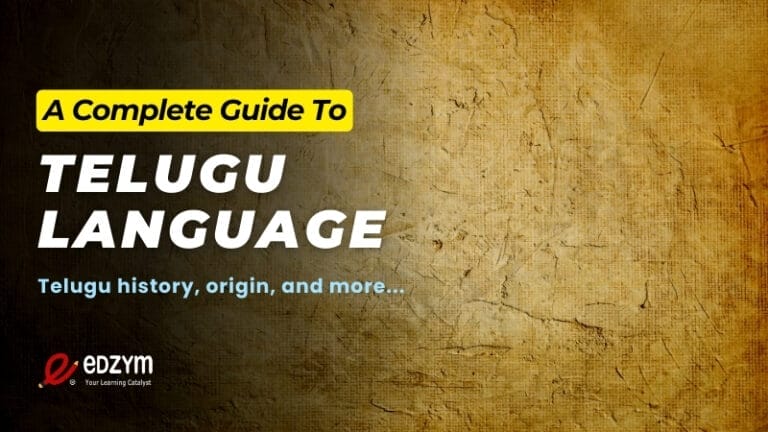Tamil Language Unveiled: Origin, History, Impact and Beyond
Tamil language is one of the oldest languages in the world, holds a special place not just in India but globally for its rich cultural and linguistic heritage. In this article, we’ll embark on a journey to explore the origins, fascinating history, everyday usage, and the modern-day significance of the Tamil language.
Tamil isn’t just a means of communication; it’s a testament to the enduring legacy of a civilization that has thrived for millennia. From its ancient beginnings to its vibrant presence today, Tamil continues to shape identities, bridge communities, and preserve a wealth of knowledge and artistry. Join us as we uncover the remarkable story of Tamil, from its roots in antiquity to its dynamic role in the contemporary world.

Origins of Tamil Language
The Tamil language has deep historical roots that stretch back thousands of years. It belongs to the Dravidian language family, which is primarily spoken in South India and parts of Sri Lanka. Tamil is renowned as one of the classical languages of India and boasts a rich literary tradition that dates back to ancient times.
Historical Roots:
Tamil’s origins can be traced to the ancient Sangam period, which lasted from around 300 BCE to 300 CE. This era is celebrated for its flourishing literature, where Tamil poems and epics were composed and passed down orally before being written down.
Ancient Tamil Literature and Inscriptions:
Ancient Tamil literature, known as Sangam literature, provides invaluable insights into the early stages of the language. These texts include poems, epics, and philosophical works that reflect the social, cultural, and political life of ancient Tamil society. Inscriptions found on cave walls, temples, and monuments further illuminate the evolution of Tamil script and language usage over the centuries.
Dravidian Language Family:
Tamil is a prominent member of the Dravidian language family, which includes other languages like Telugu, Kannada, and Malayalam. This language family is distinct from the Indo-Aryan languages spoken in northern India and has its own unique linguistic characteristics, grammar, and vocabulary.
Understanding Tamil’s place within the Dravidian language family helps us appreciate its cultural significance and the diversity of linguistic traditions in South India. As we delve deeper into Tamil’s history, we uncover a language that has not only survived but thrived through millennia, shaping the identity and cultural heritage of millions.
Historical Evolution
The Tamil language has undergone a fascinating evolution across different historical periods, each contributing to its richness and diversity.
Sangam Period (300 BCE – 300 CE):
During the Sangam period, Tamil flourished as a classical language of literature and culture. This era is characterized by the Sangam literature, a collection of poems and epics composed by Tamil poets known as Sangam poets. These works provide valuable insights into the early Tamil society, its customs, beliefs, and the language’s poetic forms and grammar.
The Sangam literature includes two major collections: Ettuthogai (Eight Anthologies) and Pattupattu (Ten Idylls). These texts were composed by numerous anonymous poets and provide insights into ancient Tamil society, its customs, beliefs, and natural surroundings.
Medieval Period (600 CE – 1500 CE):
The medieval period witnessed significant developments in Tamil language and literature. It saw the emergence of devotional literature, particularly the Bhakti movement, which contributed to the growth of Tamil as a language of religious expression.
This devotional Bhakti movement saw the emergence of saints and poets who composed hymns and songs expressing their intense devotion to various deities, including Shiva, Vishnu, and the goddesses. Notable figures include Nayanars (devotees of Shiva) and Alvars (devotees of Vishnu). The influence of Sanskrit on Tamil vocabulary and literary styles also became pronounced during this time.
Modern Period (1500 CE onwards):
In the modern period, Tamil continued to evolve with influences from colonial encounters, particularly with European powers like the Portuguese, Dutch, and British. These interactions brought about changes in vocabulary and introduced new literary forms and printing techniques. The 19th and 20th centuries saw a resurgence in Tamil literature and the establishment of modern literary conventions.
Writers like Subramania Bharati, Bharathidasan, and Sundara Ramaswamy contributed to the growth of Tamil literature through poetry, novels, and essays, addressing topics such as nationalism, social justice, and cultural identity.
Changes in Script and Dialects:
Throughout its history, Tamil language has experienced changes in script. The ancient Tamil script evolved into the modern Tamil letters used today. Dialectal variations within Tamil-speaking regions also developed, influenced by geographical factors and cultural interactions.
Changes in Script and Dialects:
Tamil numerals have evolved significantly over time. Initially influenced by Brahmi script during the ancient Sangam period (circa 3rd century BCE to 3rd century CE), these numerals gradually developed more standardized forms during the medieval period. The Tamil numerals used today—௦ (0), ௧ (1), ௨ (2), ௩ (3), ௪ (4), ௫ (5), ௬ (6), ௭ (7), ௮ (8), and ௯ (9)—became firmly established in modern usage. Although Arabic numerals are predominant in the digital age, Tamil numerals remain significant in cultural contexts and formal documents, reflecting their ongoing cultural heritage.
Influences from Other Languages and Cultures:
Tamil has been enriched by interactions with various languages and cultures over time. Sanskrit, for example, contributed loanwords and influenced the syntax and literary styles of Tamil. Persian and Arabic introduced words related to trade and religion. Colonial influences introduced vocabulary from European languages, shaping Tamil’s modern lexicon.
Understanding the historical evolution of Tamil reveals a language that has continuously adapted and grown, reflecting the dynamic cultural and social changes in South India and beyond. Today, Tamil stands as a testament to its enduring legacy and the resilience of its speakers in preserving their linguistic and cultural heritage.

Linguistic Features of Tamil Language
Tamil possesses unique linguistic characteristics that distinguish it among the world’s languages, reflecting its ancient roots and cultural vibrancy.
Phonetics:
Tamil phonetics are notable for its distinct set of vowels and consonants. It features a rich inventory of sounds, including short and long vowels, nasal sounds, and retroflex consonants. The pronunciation of Tamil words is precise and clear, influenced by its phonetic script.
Grammar:
- Cases: Tamil employs a system of grammatical cases to indicate relationships between nouns and other parts of speech. These cases include nominative, accusative, genitive, dative, locative, and instrumental cases.
- Verb Conjugation: Verbs in Tamil language are conjugated based on tense, aspect, mood, person, and number. Tamil verbs undergo significant changes to indicate these grammatical features, reflecting a complex yet structured approach to verbal communication.
- Syntax Peculiarities: Tamil syntax is characterized by a subject-object-verb (SOV) word order in basic sentences. It emphasizes the relationship between words through suffixes and agglutinative constructions, where affixes are added to a root to express meaning.
Regional Variations and Dialects:
Tamil exhibits regional variations and dialects across Tamil-speaking regions. These variations are influenced by geographical factors, historical interactions, and cultural distinctions. Some notable dialects include:
- Chennai Tamil: Urban Tamil language dialect influenced by modern trends and colloquialisms.
- Madurai Tamil: Spoken in and around Madurai, known for its classical and literary usage.
- Singaporean Tamil: Adapted to the cultural context of Tamil speakers in Singapore, with influences from English and Malay.
- Sri Lankan Tamil: Spoken in Sri Lanka, with influences from Sinhala and other local languages.
These regional variations enrich Tamil’s linguistic diversity while maintaining its core structure and vocabulary. They highlight Tamil’s adaptability and cultural significance across different communities and contexts.
Exploring the linguistic features of Tamil not only reveals its complexity and beauty but also underscores its role as a language that continues to evolve while preserving its rich heritage and identity.
Cultural Significance of the Tamil Language
The Tamil language holds profound cultural significance, serving as a cornerstone of identity and heritage for Tamil-speaking communities around the world. Its influence spans across various aspects of cultural life, from religious practices and rituals to music, dance, and literature.
Role in Religious Practices and Rituals:
Tamil language and literature have deeply intertwined with religious practices and rituals, particularly within Hinduism. Ancient Tamil literature, such as the Sangam texts and devotional hymns of the Bhakti movement, contain poetic expressions of devotion to deities like Shiva, Vishnu, and Murugan. The language is used extensively in temple rituals, prayers, and ceremonial songs, preserving spiritual traditions and fostering a sense of community among worshippers.
Influence on Music, Dance, and Other Art Forms:
Tamil culture celebrates a rich tradition of music, dance, and performing arts where language plays a pivotal role. Classical forms of Tamil music, such as Carnatic music, rely on Tamil lyrics to convey themes of love, devotion, and philosophical inquiry. Traditional dance forms like Bharatanatyam often feature Tamil-language compositions, enhancing storytelling and emotional expression through movement.
Literary and Folklore Traditions:
Tamil literature, spanning from ancient Sangam poetry to modern novels and essays, captures the ethos and experiences of Tamil-speaking communities across history. Folklore and oral traditions passed down through generations enrich Tamil culture with tales of heroes, myths, and moral lessons. These narratives, often conveyed in regional dialects, preserve local customs and beliefs, reinforcing cultural identity.
Contemporary Significance:
In contemporary times, the Tamil language continues to thrive as a medium of expression in literature, cinema, and media. It serves as a symbol of cultural pride and resilience, fostering cultural exchange and dialogue both within Tamil Nadu and among the Tamil diaspora worldwide.
In essence, the Tamil language transcends mere communication; it embodies the soul of a vibrant culture, nurturing artistic expression, spiritual devotion, and communal solidarity. Its enduring legacy underscores its pivotal role in shaping the cultural fabric of South India and beyond.
Contemporary Usage of the Tamil Language
Tamil language usage today reflects its enduring importance both domestically in India and internationally, encompassing various domains from official status to media and digital platforms.
Overview of Tamil Language Usage:
Tamil is primarily spoken in the Indian state of Tamil Nadu and the union territory of Puducherry, where it serves as the official language. It is also widely spoken in parts of Sri Lanka, Malaysia, Singapore, and among Tamil diaspora communities globally. As one of the 22 scheduled languages recognized by the Indian Constitution, Tamil enjoys significant legal protection and promotion within its native regions.
Official Language Status:
In India, Tamil holds official language status in Tamil Nadu and Puducherry. This recognition extends to government administration, judiciary, education, and public services, ensuring that Tamil remains integral to regional governance and public discourse. Internationally, Tamil is recognized as a minority language in countries with significant Tamil-speaking populations, advocating for its preservation and promotion.
Tamil in Media, Education, and Digital Platforms:
- Media: Tamil language media, including newspapers, magazines, television channels, and radio stations, play a crucial role in disseminating news, entertainment, and cultural content to Tamil-speaking audiences worldwide. Tamil cinema, known as Kollywood, is renowned for its unique storytelling and has a global audience.
- Education: Tamil is a medium of instruction in schools and universities across Tamil Nadu and Puducherry. Efforts are made to promote Tamil literature, history, and culture through educational curricula, ensuring its continuity among younger generations.
- Digital Platforms: With the advent of digital technology, Tamil has expanded its presence on digital platforms, including websites, social media, and mobile applications. Digital content in Tamil caters to diverse interests, from literature and news to entertainment and e-commerce, fostering a vibrant online community of Tamil speakers.
The contemporary usage of Tamil exemplifies its resilience and adaptability in a globalized world while affirming its cultural significance and linguistic diversity.
Challenges and Preservation Efforts of the Tamil Language
The Tamil language, despite its rich heritage and widespread usage, faces several challenges in the modern era. Efforts to preserve and promote Tamil are crucial to ensuring its continuity and vitality.
Challenges Facing Tamil Language Today:
- Standardization: Maintaining linguistic standards across different dialects and variations poses a challenge. Variations in pronunciation, vocabulary, and grammar among regional dialects can sometimes lead to difficulties in communication and comprehension.
- Modernization and Influence of Other Languages: Globalization and technological advancements bring new vocabulary and expressions into Tamil, impacting its purity and traditional usage. Balancing modernization with the preservation of cultural and linguistic integrity is a delicate task.
- Digital Age Adaptation: While digital platforms provide opportunities for language dissemination, they also pose challenges in terms of language quality, script usage, and the dominance of English and other languages on the internet.
- Educational Emphasis: The emphasis on English as a medium of education and employment can sometimes overshadow efforts to promote Tamil literacy and education, particularly in higher education and professional spheres.
Efforts to Preserve and Promote Tamil:
- Language Policies: Governments in Tamil Nadu and Puducherry have implemented language policies to promote Tamil in education, administration, and public life. These policies emphasize the use of Tamil in official communications and encourage its study from primary education onwards.
- Literary and Cultural Promotion: Institutions and organizations dedicated to Tamil literature and culture play a vital role in preserving and promoting the language. They organize literary festivals, seminars, online Tamil courses, and workshops to celebrate Tamil literary works, fostering a sense of pride and awareness among its speakers.
- Digital Initiatives: Efforts are underway to digitize Tamil literature and make it accessible online. Digital platforms in Tamil offer a wide range of content, including e-books, websites, and mobile applications, to cater to diverse interests and promote Tamil language usage.
- Community Engagement: Community-driven initiatives by Tamil organizations and cultural associations focus on teaching Tamil to younger generations, organizing cultural events, learn Tamil through English initiatives and supporting language schools. These efforts aim to instill a sense of identity and appreciation for the language and heritage.
- International Recognition: Advocacy efforts by Tamil diaspora communities seek international recognition and support for Tamil as a minority language, ensuring its preservation and promotion outside of its native regions.
In conclusion, while the Tamil language faces challenges in the modern era, concerted efforts through policy initiatives, cultural promotion, and community engagement are crucial in preserving its linguistic richness and cultural identity for future generations. By addressing these challenges proactively, Tamil continues to thrive as a vibrant language with a deep-rooted legacy.
Conclusion
In this comprehensive exploration of the Tamil language, we have delved into its origins, historical evolution, cultural significance, contemporary usage, challenges, and preservation efforts. Here are the key points summarized:
- Historical and Cultural Richness: Tamil boasts a rich cultural heritage dating back to ancient times, evidenced by its Sangam literature, Bhakti movement contributions, and modern literary achievements. It serves as a symbol of cultural identity and continuity for Tamil-speaking communities worldwide.
- Linguistic Complexity: The Tamil language is characterized by unique phonetics, grammar with intricate verb conjugation and case systems, and regional dialects that reflect its diverse linguistic landscape.
- Cultural Significance: Tamil language and literature play integral roles in religious practices, rituals, folklore, music, dance, and other art forms, preserving and promoting Tamil culture across generations.
- Contemporary Usage: Tamil holds official language status in Tamil Nadu and Puducherry, and its influence extends globally through media, education, and digital platforms, showcasing its adaptability and relevance in the modern world.
- Challenges and Preservation Efforts: Despite facing challenges such as standardization, modernization, and educational emphasis on English, concerted efforts through language policies, cultural promotion, digital initiatives, and community engagement are ensuring the preservation and promotion of Tamil.
Future Prospects
Looking ahead, the future of the Tamil language appears promising yet challenging. Continued efforts in standardization, digital adaptation, and educational reinforcement will be crucial in maintaining Tamil’s linguistic integrity and relevance. As global connectivity increases, there are opportunities to expand Tamil language usage and appreciation beyond its traditional boundaries.
The enduring legacy of Tamil lies in its ability to adapt while preserving its cultural roots, ensuring that future generations inherit a language rich in history, literature, and cultural identity. By nurturing Tamil through education, cultural exchange, and technological innovation, we can ensure that it continues to thrive as a vibrant language of expression and communication in the global arena.
In conclusion, Tamil stands not just as a language but as a testament to the resilience and creativity of its speakers, embodying a legacy that enriches the world’s linguistic diversity and cultural heritage.
If you’re interested in learning Tamil, we can help you with an experienced native tutor. Please fill the form below and our counselors will arrange a free personalized session to experience the beauty of Tamil language.









